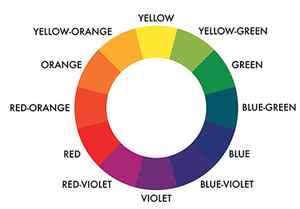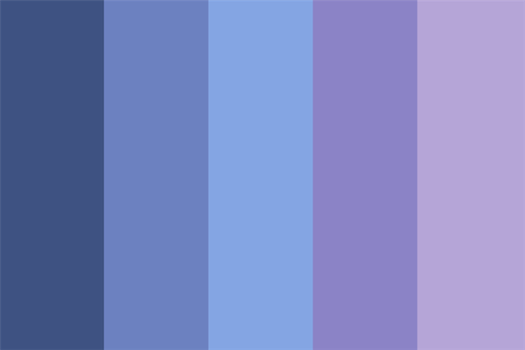Typically, purple dyes last for about 4 to 6 weeks. However, since the purple dye is highly pigmented, there’s a high chance that it will fade a little every time you wash it.
Can You Dye Purple Over Red Hair?
Janella is a registered pharmacist with over a decade of experience as a professional writer, specializing in hairstyles. She researches hairstyle & hair color trends, tests the latest haircare tools and products to help people take the right decision.
Do you have natural red hair, or is your current hair reddish, and you wish to switch to a more vibrant purple shade?
If so, you might ask, can you put purple over red hair?
Of course, you can always do that. But the most important question would be— how would that turn out?
If you’re serious about joining the purple movement, we recommend reading this simple guide before adding purple dye to your red hair.
Can I Dye Purple Over Red Hair?
Will purple dye work on red hair?
Yes, you can dye purple over red hair, but you can’t achieve a true purple shade when you do so. If your hair’s red shade is stronger than the purple dye, burgundy may be the color that would come out of the mix.
On the other hand, it might come out in a purple tone (but still on the red-violet spectrum) if the purple dye is stronger than the redness of your hair.
How to Dye My Red Hair Purple?
If you want a true purple shade, there are two ways you can dye your red hair purple.
First, decide which shade of purple you want, considering your skin tone. Here’s a simple guideline:
- For women with cooler or lighter skin tones, a pastel or more vibrant shade of purple is recommended. To achieve these shades, Method #1 is the way to go.
- For women with darker skin tones, a deeper or darker shade of purple. If you want to go for this color, use Method #2.
Method #1: How to Dye Red Hair Purple with Bleaching
If you’re going for a vibrant purple shade or a lavender or lilac color, you must get rid of the red hues in your hair. Bleaching is the only way to do this.
With that said, here are the steps you can take:
Step 1: Assess your hair condition.
We all know that the bleaching process can be damaging to your hair. That’s why you should examine your hair strands first to ensure they’re free of any damage (i.e., breakage, dryness, and dullness).
If your hair fails this assessment test, you should delay the bleaching session for a few weeks. Instead, use natural oils or deep conditioning treatments to nourish and hydrate your hair.
If your hair doesn’t show any of these symptoms, you can proceed to the next step.
Step 2: Prepare the bleaching mixture.
Get a plastic bowl and mix the bleaching powder with a 30-volume peroxide. Don’t use peroxide with a higher volume to prevent hair damage.
Step 3: Bleach your red hair.
Using a brush, apply the bleaching mixture to your hair strands. Leave around 1cm of length from the roots, then dye to the ends of your hair.
After dyeing your hair’s lengths, you can apply the bleaching mixture to your roots.
Let the dye sit for around 30 to 40 minutes, but check on the color every 10 minutes.
Step 4: Rinse off the dye.
Once all the red hues in your hair have disappeared and already taken on a yellow shade, you can rinse off the dye. You can do this using a color-protecting shampoo and conditioner or a rinsing cream.
Step 5: Apply the violet dye.
Dry your hair first before applying the new color. Then, follow the instructions in the packaging to keep your hair looking healthy and your new hair color as vibrant and vivid as possible.
Method #2: How to Dye Red Hair Purple without Bleaching
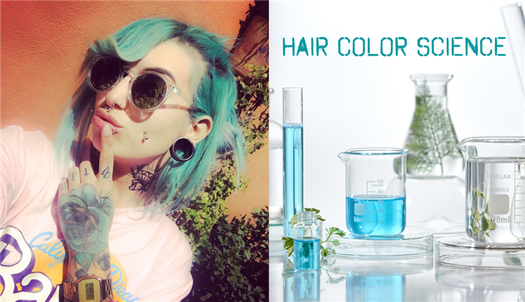
If you’re going for a darker or deeper shade of purple, there’s no need to bleach since they have a similar tone to reds.
But one issue remains—you won’t be able to achieve a true purple shade (but more of a red-violet shade). If that’s okay with you, you can proceed to the following steps.
If not, you should seek the services of a professional hair stylist, as they can customize the right shade of dye to achieve a true purple color.
Step 1. Prep your hair for the dyeing process.
A few days before your scheduled hair coloring session, make sure to wash your hair thoroughly to get rid of dirt and buildup,
But on the day of the session, don’t wash your hair to preserve the natural oils of your hair.
Step 2. Prep the dye.
Mix the color solution and developer following the ratio and instructions stated in the product’s packaging.
Step 3. Section your hair and apply the dye.
Use a clip to divide your hair into multiple sections. The more sections, the better.
After that, apply the dye to your hair using a brush. Make sure that all your hair strands are well coated. Check your head from all sides to ensure you’ve colored your hair thoroughly.
Cover your hair with a plastic cover or shower cap, and let the dye sit for around 20 to 30 minutes.
Step 4. Rinse off the dye.
Rinse your hair using warm water and a rinsing cream or color-protecting conditioner.
Go from Magenta/Red to vibrant purple?
Hey everyone!! I’ve had a hairdresser my whole life but last year I moved to Georgia alone and didn’t have any money and started doing my own hair. You guys helped me achieve the EXACT color I wanted last time, so I figured I would ask for your help again. My hair is naturally a very dirty blonde (I miss the days when it was naturally platinum lol), and right now I dye it with Magenta from Loreal Hicolor. That turns it a bright pinkish red. Then to darken it, I use a whole container of Vampire Red from Manic Panic mixed with 1/4 container of Purple Haze from Manic Panic. I’ll post a picture of the color I am now. Please excuse the fro and the bad makeup. I was on my way home, not on the way out and looking fresh lol. But the sun was out and the picture is very accurate in color. It’s bright. So I was thinking of going this very vibrant purple, and I wanted to know how to get there (or close to it) without bleaching my hair. Bleach is not an option right now. Purple Haze by itself turns my red a very, very dark purple, almost black. Just wondering if there are any other manic panic colors I can use or any other brand. or if I even use something other than the Magenta in Loreal Hicolor to lighten. The amount of bleach in that I’m okay with. any ideas? lol.
Kristen J.
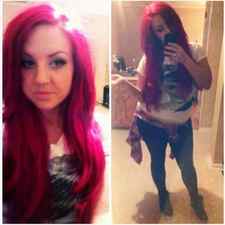
another.
Kristen J.

And the purple I want
Alyx T.
You could use any purple over top. Like I used to use magenta and red hi color, fade it for 3-4 washes and then put special effects deep purple over top and it’d come out super similar to that photo. A purpley red.
And remember you really only have to do your roots with the hicolor. Other than that just refresh with veggie dye (manic panic, special effects etc)
Kristen J.
Yes that’s what I do, just the roots with the hicolor! I just meant the very first time I did it, I did the whole thing with Magenta.
Ok I’ll look into the Special Effects Deep Purple. Can you get that at Sally’s? I’m just nervous because Purple Haze is supposed to be pretty vibrant and over this red color it turns it almost black on me. i did a strand test before lol
Alyx T.
Unfortunately special effects is only sold at select retailers and online.
But here’s a picture gallery of purple hair. They list the dyes too.
http://haircrazy.info/gallery/purple/
If you use a pinky purple, or even mix your own by mixing a pink based red with a purple based blue you could get a light but bright purple. Purple haze is quite dark naturally, so putting it on a dark base will definitely make it darker. If you choose a bright intense purple it’ll show up a bit darker, but not too dark. If you can tell me where you live (country or state is fine) or what brands you know are available I can suggest purples by what’s available to you 🙂
Kristen J.
Ok cool! That gallery is great, thank you! I’m in Atlanta, Georgia. I don’t know what’s available. I only have access to Sally’s, really lol. I can’t shop at Cosmo Prof or those type of places. How do I find out what the base color of the dye is?
Alyx T.
Sally’s really only has manic panic and punky colors here in canada, so manic panic is probably your best option. You might have small novelty shops that sell other dyes.
And it’s pretty easy with hair dye if you google the colors to base color usually sticks out. But I find the best way to tell is to google “manic panic _____ faded” and for example MP ultra violet is a blue based purple, so it fades to a silvery purple rather than pinky which a red based one would.
Hair dye is basically like painting though. They consist of a primary color and they mix whatever colors into it. So with ultra violet they mix more blue in then red to get that purple.
I hope this makes sense lol. And if you have any other questions I’ll try my best to answer. 🙂
Kristen J.
Okay so right now I’m thinking that I should still dye my roots with Loreal Hicolor Magenta. but I can mix the whole thing of Fuschia Shock from Manic Panic, and a liiittle bit of Purple Haze to darken it to get that. I tried searching for the “manic panic __ faded” thing to find out their base colors but I couldn’t find anything lol. I just remember that someone on here told me purple haze was a pink base. and I’m just guessing Fuschia Shock is? because it’s actually pink? lol. I’m going to buy them tomorrow and try it on one of my extensions and then if it’s good, then on a small piece of my real hair. we’ll see! I’m just tired of this red, lol. And you’re helping so much, thank you!! That paragraph did actually make a lot of sense. I get the thing about fading to silver rather than pink. I’m getting smarter!! lol. 🙂
Bree B.

This stuff will turn your hair the color of the girls hair in the front. So the darker purple, but certainly not black. It will very noticeably be purple. It’s available on amazon. You’re going to need AT LEAST 3 containers if not 4. It’s very conditioning though. Let me see if I can find a pic of my daughter’s hair.
Welcome to Splat’s School of Brilliant, Vibrant Hair Color! Class is about to begin…
All right class, settle down. Get your notebooks out and your pencils ready. Today’s lecture is dedicated to the nitty-gritty world of…. color science.
To many people, science and art are polar opposites when it comes to subjects in school. Science is all about complex systems that exist underneath the surface, and art relies more on creative expression in the very visible world. Science asks, “Why?” while Art says, “Ta-da!”
At Splat, we run into all kinds of questions about how and why hair color works (and sometimes, doesn’t exactly work!). Most of these questions pop up when something goes wrong with hair color, and in an effort to help you understand the chemistry behind coloring your hair, we’re dedicating this article to the Art of Color Science.
First, let’s go over the basics. Semi-permanent hair color (like the kind used in most of Splat’s products) coats the surface of the hair – without penetrating deep into the cuticle. When you coat the surface of your hair, the color is deposited directly on top of the color you already have. Learn all about semi-permanent hair dye here
When it comes to using color, it’s helpful to keep the color wheel in mind.
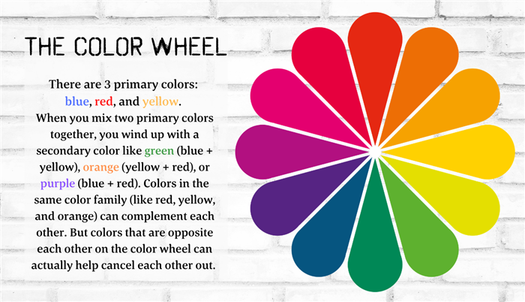
- What’s The Big Deal About The Color Wheel?
There are 3 primary colors: blue , red , and yellow . When you mix two primary colors together, you wind up with a secondary color like green (blue + yellow), orange (yellow + red), or purple (blue + red). Colors in the same color family (like red, yellow, and orange) can complement each other. But colors that are opposite each other on the color wheel can actually help cancel each other out. Yellow is opposite purple on the color wheel, and this is why most people recommend using violet-based toners or purple shampoos if your hair is too yellow or brassy.
If you’re planning on dyeing your hair a vivid color (like bright orange, teal, pink, violet, ruby red, and so forth), the color will show up best on hair that’s been pre-lightened as closely as possible to white. That’s because those bright-colored tones need a white ‘background’ in order to show up as true as possible.
And that brings us to our first topic of discussion…
I Dyed My Hair Blue But It Came Out Green!
Blue hair is a beautiful thing, and that’s why we’ve come up with a huge collection of blue-inspired color kits. But if you have too much yellow in your hair after bleaching it, you run the risk of getting green-tinted hair. That’s because blue layered over yellow equals green. If you’ve bleached your hair and still have some yellow leftover, a toner will help remove the yellow so that your new color can achieve its truest results. Be sure to wash/rinse thoroughly after toning, before you move onto dyeing to your strands.
This can beg the question.
- Why Did My Hair Turn Out Yellow In The First Place?
This answer is very scientific, so bear with us. Your hair is mainly made from a protein called keratin, but it’s also made with melanin , which is where your virgin color comes from. When you bleach your hair, an oxidation process occurs that makes your melanin (or virgin color) become colorless. Yellow is a natural byproduct of bleached keratin so the result of bleaching can leave behind a yellow tint (and, if your hair is really dark, it can leave behind an orange tint if your hair hasn’t fully processed). Click here to learn more about bleach and all the amazing ways to use it!
- How Does Adding Purple Work on Yellow Hair?
If you look at the color wheel, purple is the opposite of yellow. As its opposite, purple is the most effective way to cancel out yellow, and it’s used in many toners for that reason. It counteracts those unwanted brassy tones, but keep in mind: using a toner still deposits color onto your hair so you want to be sure to monitor the process and the only tone until the color has neutralized to nice ash or white to avoid processing so long that it then begins to turn purple.
- How Do I Know If I Need to Tone My Color?
Splat’s kits come with everything you need to get bright, bold, or brilliant hair at home. We don’t include toner because it’s an extra step that not everybody needs. If you’re going to be dyeing your hair a darker color you probably won’t need toner since the dye itself will have good enough coverage. If you’re going for a lighter shade (like a pastel pink or an ocean blue), you likely will want to first tone your hair to help neutralize any leftover yellow.
- How Can I Cancel Out Yellow WITHOUT Using A Toner?
If you still have a little yellow left in your hair after bleaching it, try adding a few drops of a more pigmented, similar color (like a few drops of Pink Fetish into a bottle of Midnight Rosetta) to increase the saturation and reduce the need for a neutral tone base. If you’re going for a blue color, try adding a few drops of Splat’s Purple Desire to the blue dye to give it more of a cool tone to cancel any yellow – but be sure to do a strand test first! (Keep in mind, we offer single color packets of all of our original color kits so there are a ton of color options to get the most saturated color that is all you). You can also add a few drops of purple dye (like Lusty Lavender) to a plain conditioner and wear it as a mask until the color has neutralized to help cancel out the yellow in your hair. Purple shampoo is also a great way to pull yellow tones out of your hair. Remember, though – if you’ve achieved a near-white color after bleaching, you don’t need to take the extra step to tone before dyeing. Our Single Foil Packs are a great add-on to your shopping cart to customize the color of your dreams.
- Will It Work If I Mix Two Colors Together, Or Will I Just Get A Muddy Mess?
Yes, you can mix colors – within reason! We love mixing colors and we encourage you to try it. It won’t do much to add Orange with Midnight Indigo (because the blue will overpower the orange), but if shades are from the same side of the color wheel or you want to make a color warmer or cooler , have at it! Try adding some Pink Fetish to Orange Fireballs for a rich fiery orange, or Lusty Lavender with Blue Envy for a deep purple color.
- How Can I Go From Blue to Pastel Pink?
First, set some realistic expectations! It’s going to take time to go from a midnight blue to pastel pink. You’ll need to let the blue color fade significantly first. You can use clarifying shampoo and hot/warm water to help speed the fading process along. Once your color fades, use the color wheel to transition over time by recoloring with the next transitional shade. This is where color science really comes into play! When your blue color fades, recolor with the next shade over in the direction you want to go. In this case (Blue -> Pink) you would reach for Splat Naturals in Lavender to get started in that color transition. Once that fades, recolor with the next shade over – a pink dye (like Naturals in Pink). As that pink fades you’ll now have the right base for pastel so when you’re ready to color again, simply add Splat’s Pastel Mixer to your Naturals Pink, and voila! You’ve transitioned from blue to pastel pink all on your own – without having to bleach your hair again. You’ll have put your color science skills to the test because that’s color science at its best. And it’s something you can easily do, on your own, at home!

